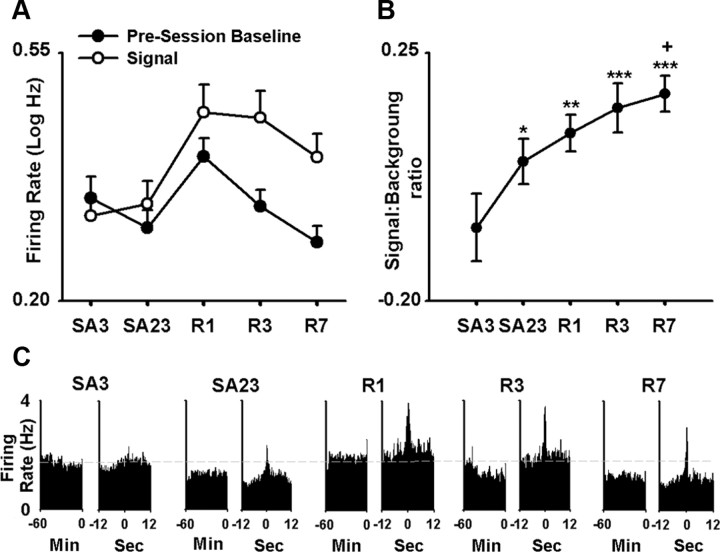Figure 6.
A persistent and progressive net increase in NAc firing time-locked to the nicotine-reinforced lever press. A, Average signal and background firing rates [i.e., average log10(x + 1), abbreviated log Hz] of all recorded neurons (i.e., all task-activated and all task-nonactivated neurons combined) in the nicotine group are plotted as a function of recording day (i.e., SA3 and SA23 of initial SA; and R1, R3, and R7 of reexposure). The signal firing rate is the average peak firing rate time-locked to the nicotine-reinforced press (see Results). The background firing rate is average firing rate during the 60 min baseline period. B, The average signal:background ratio is plotted as a function of recording day (i.e., SA3 and SA23 of initial SA; R1, R3, and R7 of reexposure). The single, double, and triple asterisks denote a significant difference relative to the third day of initial SA with p < 0.05, p < 0.01, and p < 0.001, respectively. The symbol + denotes a significant difference relative to the 23rd day of initial SA (p < 0.05). Error bars indicate SEM. C, Average baseline and SA firing rates (i.e., average hertz per 0.1 s bin for all recorded neurons combined) are plotted as a function of recording day (i.e., SA3 and SA23 of initial SA, and R1, R3, and R7 of reexposure). For each recording day, two average perievent histograms are shown: one displays average firing rate (i.e., average hertz per 0.1 s bin) during the 60 min baseline period (left histogram of the pair), and the other displays average firing rate (i.e., average hertz per 0.1 s bin) during the 12 s before and after the nicotine-reinforced lever press (right histogram of the pair).

